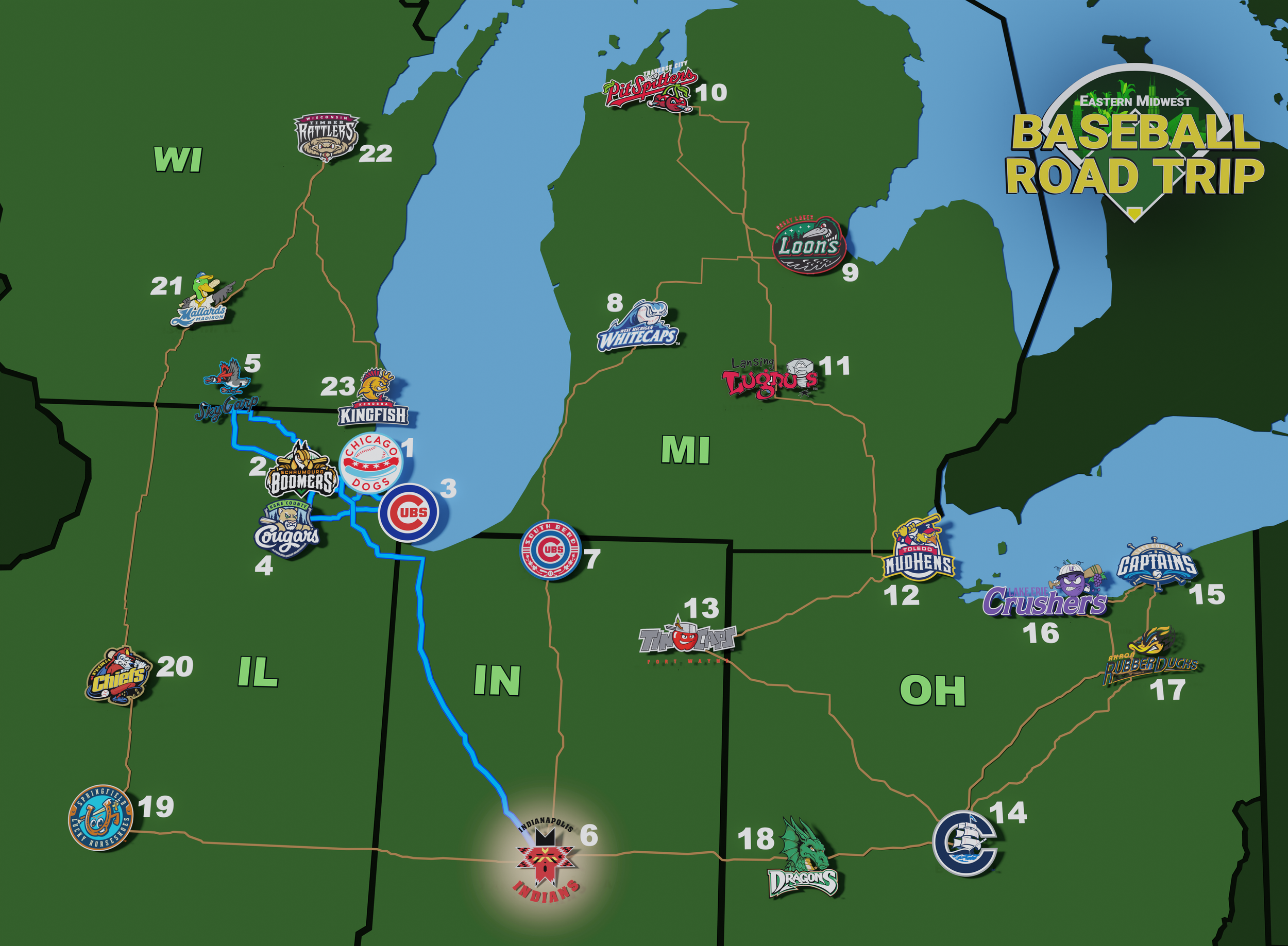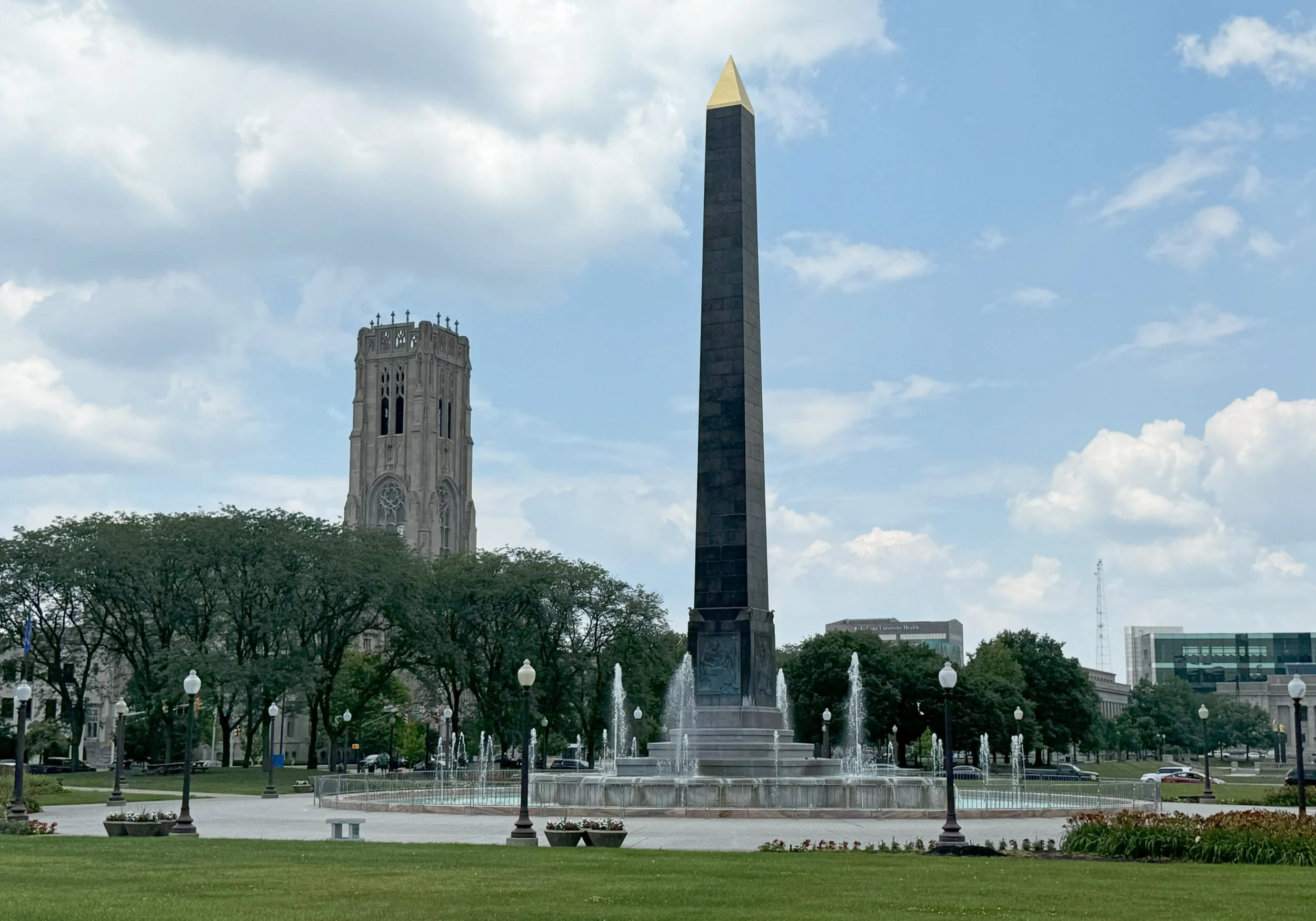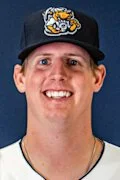Indianapolis Indians
We make a big drive for Game 6 of 23 to Indianapolis, Indiana. After stopping to see the local monuments, we visit the Indiana State Museum. Then it’s off to Victory Field, dubbed "Best Minor League Ballpark in America” and home to the Indianapolis Indians, the Triple-A affiliate of the Pittsburgh Pirates.
Making a schedule for a determined and relentless ballpark road trip — one in which you endeavor to see a different team in a different ballpark each and every day for three solid weeks — will eventually mean a couple of Big Dumb Drives. Your itinerary will have 10 excellent days of fortunately connected ballparks before needing to zag across the map for four or five hours to connect to the rest of the route.
In our case, we needed to travel northwest to see the Beloit Sky Carp for Game 5 before doubling back southeast to see the Indianapolis Indians for Game 6.
We had a lot of nice drives on this road trip, but this was not one of them. We spent tedious time navigating construction and traffic in the corridors of concrete south of Chicago. Then things opened up a bit, and by mid-day we were in Lafayette, Indiana. The town is home to the Lafayette Aviators of the collegiate Prospect League, a league we would encounter later in Springfield. Our goal was a quick lunch, so we stopped at Christos New City Grill for a terrific Reuben and were soon back on the road to Indianapolis.
When we arrived in the capital of Indiana, we stopped at several landmarks downtown, including the Indiana War Memorial & Museum (dedicated to soldiers who died in World War I), the neighboring Veterans Memorial Plaza (or Obelisk Square), the state capitol (built in 1888), and the Soldiers & Sailors Monument (originally built to honor Hoosiers who served in the Civil War but now memorializing soldiers from other wars of the 18th and 19th centuries).
Indiana War Memorial and Museum
Veterans Memorial Plaza
State Capitol
Soldiers & Sailors Monument
Indiana State Museum
We made our one sightseeing stop in town at the Indiana State Museum, which covers the history, culture, science, and art of the state from prehistory to the present day. A steam clock near the front door welcomes visitors with eight brass whistles that play "Back Home Again in Indiana."Exhibits in the museum trace the history of the nomadic Paleo-Indians of 8000 BC, who hunted mastodons and made stone tools; later indigenous tribes of the Archaic and Woodland periods who began to settle more permanently; and the subsequent Mississippian culture that arose around 1000 AD and collapsed just before the arrival of Europeans.
Those Europeans were French — first explorers, then fur traders, and finally soldiers and settlers. France ceded the area to the British in 1763 following the French and Indian War. After the American Revolution, the land became part of the vast Northwest Territory claimed by Congress in 1787, encompassing modern Wisconsin, Illinois, Michigan, Ohio, and Indiana. A good chunk of that became known as Indiana Territory in 1800, and in 1816, Indiana became the 19th state in the Union.
Other exhibits explore natural history, pioneer life, the state’s automakers, its impact during World War II, the contributions of its African-American citizens, basketball, the Indianapolis 500, and celebrity locals such as James Dean, Steve McQueen, Larry Bird, Michael Jackson, and David Letterman.
Indiananapolis Indians
After a quick rest back at the hotel, Dad and I drove out to Victory Field, home of the Indianapolis Indians, the Triple-A affiliate of the Pittsburgh Pirates. The ballpark is located on the east side of White River near a state park and just blocks from Lucas Oil Stadium (home of the Indianapolis Colts) and a few more blocks from the state capitol.Opened in 1996 for $20 million, Victory Field has been named "Best Minor League Ballpark in America” by both Baseball America and Sports Illustrated. Its attractive brick edifice contains 12,230 fixed seats and can accommodate another 2,000 fans on lawn seating. It replaced Bush Stadium — renamed Victory Field in 1942 as part of the war effort — which was the home of the Indians from 1931-1996 and a handful of Negro leagues teams as well. The Indians averaged 8,005 fans per game here in 2024, second-best in the league and third-best in all of Minor League Baseball.
A steely-blue J.W. Marriott hotel dominates the skyline in left field. Otherwise, the outfield lawn seating and mature trees blend the ballpark nicely into the surrounding neighborhood.
Both Minor League Baseball and the Indians go back much further than 1931. The first minor league team in town was the Indianapolis Blues, who played in the League Alliance in 1877 before joining the major leagues the following year. Several teams called the Hoosiers played through 1901. The Indians were founded in 1902 and are the second-oldest franchise in Minor League Baseball. (The Rochester Red Wings, from 1899, are the oldest.)
The Indians began as a Class-A team, then moved up to Double-A in 1912 and Triple-A in 1946. They have won 14 league titles in their history — the last in 2000, when they also won the national Triple-A championship. Since 1939, the Indians have been affiliated with eight different Major League clubs, partnering with the Pirates since 2005.
Dad and I walked from the center-field entrance directly into the Hot Corner Gift Shop to make our merch selections for the game.
Indians apparel showcases more than just the main brand, which is based on a Navajo quilt pattern. The team occasionally appears wearing Circle City hats and jerseys, using a nickname derived from Monument Circle, at the center of which stands the Soldiers and Sailors Monument. I went with a Circle City design for my one and only hat purchase.
The team also celebrates the Indianapolis Clowns, a Negro American League team that relocated from Cincinnati in 1946 and played until 1962. Hank Aaron joined the team for about three months in 1952 before signing with the Boston Braves. The Clowns replaced him with professional baseball’s first female player, Toni Stone, who played second base in 1953 and hit .243.
Photos of former ballplayers are on display throughout the concourse at Victory Field. Indians alumni in the Baseball Hall of Fame include Joe McCarthy, Nap Lajoie, Mordecai Brown, Luke Appling, Minnie Miñoso, Harmon Killebrew, Bob Uecker, Randy Johnson, and Larry Walker.
I walked back out to the outfield, which features a view of a surprisingly attractive power station.
The center-field plaza beyond the outfield lawn includes concessions, a mini-merch stand, and games for the kids.
As I came back down the first-base side, I ran into Indians mascot Rowdie, a red bear who has been with the team since 1993.
The Indians would be facing the Iowa Cubs, and both teams were scuffling coming into the game. Indianapolis had a 30-39 record and sat in ninth place in the International league, just below Iowa, as the first half of the season came to a close.
Jake Woodford
The game got underway with a scoreless first inning. Indians starter Jake Woodford dismissed the Cubs in order. A former first-round draft pick of the St. Louis Cardinals, Woodford had signed free-agent deals with the Chicago White Sox in January and the Pirates in June after spending four seasons bouncing between Triple-A and the big leagues in the Cardinals system. He would put up a 2.44 ERA in 10 games with the Indians but ended 2024 with a 7.97 ERA in nine games at the Major League level. Woodford signed a new deal with the Colorado Rockies in early 2025 to keep the dream alive.
Trey Supak
The Cubs 6-foot-5 right-handed starter, Trey Supak, was the second-round pick of the Pirates in 2014 but was still trying to break through to the big leagues. He had left the Pirates to pitch in the Oakland Athletics and Milwaukee Brewers organizations before joining the Cubs in 2024. After beginning the season with the Double-A Tennessee Smokies, Supak had just been called up to Triple-A Iowa to take another shot. He would finish his season in Des Moines with a 4-2 record and a 4.90 ERA in 16 appearances. This would be one of his best outings, yet he too would sign with another team — the Texas Rangers — to begin 2025.
We had considered a variety of dinner options — fried tenderloin sandwich, shredded beef tacos, maybe a brat. But the team’s Hot Dog of the Homestand for the Chicago-connected Iowa Cubs was a Chicago Dog, and by now we were addicted to its charms. At once juicy, spicy, sweet, bitter, soft, and crunchy, the Chicago Dog brings a cornucopia of favor and textures. We had found a lifetime favorite in the Midwest.
In the bottom of the second, 20-year-old Venezuelan catcher Moisés Ballesteros led off with a blast over the center-field wall to give the Cubs a 1-0 lead. Ballesteros had also been promoted from the Smokies early in the season and would hit .281 in 68 games in his first go at Triple-A baseball.
As the sun began to set behind the grandstand, I made my way back to the outfield.
A mural along the balpark’s back fence depicts happy times in Circle City baseball, including an iconic shot of fan-favorite Razor Shines — who played nine seasons in Indianapolis when it was a Montreal Expos affiliate — celebrating with longtime team president Max Schumacher after a Game 7 victory over the Denver Zephyrs to win the 1986 American Association championship.
The Max Schumacher Victory Bell is also on display in right field. The 990-pound, 37-inch-wide bell is rung by a lucky fan or local celebrity after each Indians win. Schumacher was an institution in Indianapolis baseball, working for the Indians for more than 60 years after growing up a fan of the team.
The starters left the game after six innings with the Cubs still leading 1-0. Both offenses continued to poke and prod, putting a single runner on base here and there without making anything of it.
Right-hander Hunter Bigge came on in the ninth to close the game for Iowa. He allowed a two-out walk but got the next batter to ground out, ending the contest. The Harvard University alum would be traded to the Tampa Bay Rays five weeks later and would hit his stride to close out the 2024 season, giving up four runs in 15 innings for the big-league club, and notching 19 strikeouts against just three walks.
I told Dad I would meet him at the intersection just outside the center-field gate, then jogged back to the car. When I pulled out of the garage, my way was blocked by local police doing traffic control. There was no clear way to get to Dad, and my GPS — unaware of the temporary detours — lied to me repeatedly about the best way back to him. Thus began a stressful series of wrong turns, one-way streets, and more blockades during which I may have uttered an expletive, or maybe 30 to 40 expletives. It’s hard to tell. Eventually, I found my way back to Dad, and we were on our way.









